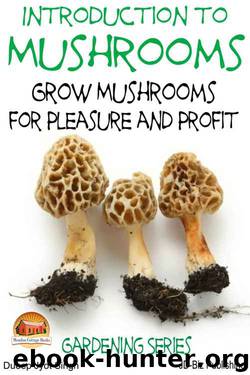Introduction to Mushrooms - Grow Mushrooms for Pleasure and Profit by Dueep Jyot Singh & John Davidson

Author:Dueep Jyot Singh & John Davidson [Singh, Dueep Jyot]
Language: eng
Format: epub
Publisher: JD-Biz Corp Publishing
Published: 2015-03-04T22:00:00+00:00
Pasteurization
You can fill in your mushroom beds and trays now. Firm them lightly with a fork. Pasteurize them for four or five days to sweeten the compost. The temperature of the compost should be around 125° Fahrenheit. It should not be above 145° Fahrenheit, which is called the peak heat or pasteurizing time.
This pasteurizing is to get rid of the extra moisture and kill off insects and fungi.
A good gardener turning over the compost is going to make sure that the compost is powdery, and not “clotted.” So if you have any compost lumps, just clout them with your fork and make them powdery again.
Many of the people composting through traditional methods are going to be disappointed that the small amount of compost obtained from huge amounts of original dung. In fact, one ton of horse dung is going to be enough to fill a 70 ft.² of bed 8 inches deep. That was after it had been composted for one whole month.
So here is another easy way, which I think is quite sensible. After one or two turns in the shed, just get the compost wet and thoroughly mixed. Then take the compost inside a warm place and subject it to a prolonged fermentation placed in your trays and in your mushroom beds, of seven days.
That means that one ton of fresh dung is going to give you enough of compost to fill 150 ft.² of a mushroom bed.
This short composting method is going to include saving time, material, space and labor. Remember that the temperature of fermenting horses dung is going to rise up to nearly 1 40°F in just one week. The surrounding atmosphere around it is also going to be muggy and humid. So do the composting in a place set apart from your abode.
Water is going to be added as early as possible, preferably as the first pile is stacked. Later waterings can be added if required, and are going to be confined to the parts which appear excessively dry.
Gypsum, also known as calcium sulfate is sprinkled on the manure at the rate of 56 pounds per ton of dung, during any one of the turns. But as we are not composting one huge ton, we are definitely going to be using much less quantities of gypsum in our backyard, are not we.
After the pasteurizing process has been done, the compost is then allowed to cool down. It is going to be planted with the spawn at 80° or 75°F.
A few days after spawning, you can tell whether the spawn is “running.” The manure around it is going to turn blue gray. 7 to 14 days later, the beds are the trays need to be covered with a layer of sterilized soil or even peat about 1 ½ inches thick. This is known as casing.
Light waterings of this casing is going to bring mushrooms into crop, about five weeks after spawning.
The temperature needs to be around 58° – 62°F. The mushrooms are going to continue
Download
This site does not store any files on its server. We only index and link to content provided by other sites. Please contact the content providers to delete copyright contents if any and email us, we'll remove relevant links or contents immediately.
Turbulence by E. J. Noyes(7942)
The Thirst by Nesbo Jo(6832)
Gerald's Game by Stephen King(4584)
Be in a Treehouse by Pete Nelson(3953)
Marijuana Grower's Handbook by Ed Rosenthal(3623)
The Sprouting Book by Ann Wigmore(3544)
The Red Files by Lee Winter(3368)
The Remains of the Day by Kazuo Ishiguro(3295)
Sharp Objects: A Novel by Gillian Flynn(2958)
Christian (The Protectors Book 1) by L. Ann Marie(2655)
Organic Mushroom Farming and Mycoremediation by Tradd Cotter(2631)
The Culinary Herbal by Susan Belsinger(2433)
Stone Building by Kevin Gardner(2353)
The Starter Garden Handbook by Alice Mary Alvrez(2285)
Lilac Girls by Martha Hall Kelly(2258)
The Unlikely Pilgrimage of Harold Fry by Rachel Joyce(2221)
The Lean Farm Guide to Growing Vegetables: More In-Depth Lean Techniques for Efficient Organic Production by Ben Hartman(2098)
Urban Farming by Thomas Fox(2061)
Backyard Woodland by Josh VanBrakle(1895)
